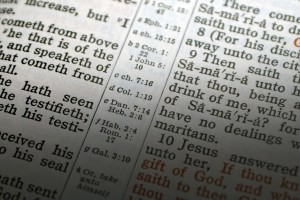 Skeptics have written quite a bit about the allegedly “irreconcilable” differences between the genealogies of Jesus recorded in the gospels of Matthew (Matthew 1) and Luke (Luke 3:23-38). The genealogies appear to be quite different, especially as each author traces the lineage from King David down to Jesus. While I also recognize the differences here, I am familiar enough with witness statements to understand why this may be the case. I often review reports from cold-cases that were written by detectives who have long since died. As they described the statements that were originally offered to them by a witness, they often appear to have documented conflicting statements from witnesses who should have seen the same thing.
Skeptics have written quite a bit about the allegedly “irreconcilable” differences between the genealogies of Jesus recorded in the gospels of Matthew (Matthew 1) and Luke (Luke 3:23-38). The genealogies appear to be quite different, especially as each author traces the lineage from King David down to Jesus. While I also recognize the differences here, I am familiar enough with witness statements to understand why this may be the case. I often review reports from cold-cases that were written by detectives who have long since died. As they described the statements that were originally offered to them by a witness, they often appear to have documented conflicting statements from witnesses who should have seen the same thing.
Years later, all I have are the written reports of the deceased detectives and apparent contradictions. Once I get the chance to interview the witness for myself, the issues begin to find resolution. I’ve learned to ask each witness not only what they saw, but how the detective originally interviewed them. This is an important second question, because it often solves an apparent contradiction in the original reports. It turns out that what the detective was trying to accomplish in the interview often shapes what he finally recorded on paper. In addition, if I have access to other archived reports from the detective who conducted the interview, I may learn something about his approach to report writing that will help me understand why he wrote a report in a particular way. If I hope to address a jury and explain an apparent contradiction between witnesses as recorded by the original detective, I’m going to have to learn about the contributing factors that motivated the documentation in the first place. What was the detective’s objective when he wrote the report? What was of interest to him? What was he trying to accomplish?
In a similar way, we need to understand what might have been motivating Matthew and Luke as they recorded their genealogies of Jesus. In this regard, I think the scholarship that precedes me has done an excellent job of uncovering two reason contributing factors that might explain the differences:
Minor Reasonable Contributing Factor:
Some theologians and scholars have noted that one of the authors may simply have been more interested in including members of Jesus’ “legal” lineage who are related to him through “levirate marriage”. Back in these days, if a man passed away without any sons, the man’s brother would marry the widow to produce a son who could carry on the original man’s name. The son could then be listed under the genealogy of his natural father or his legal father. This might explain why Joseph is listed as the son of Heli in Luke but the son of Jacob in Matthew. While this may explain some of the differences between genealogies, there are too many variances to trust this minor contributing factor as a comprehensive explanation.
Major Reasonable Contributing Factor:
A more likely contributing factor, in my view, is the difference in the initial objectives of each author. Matthew appears to be writing to a Jewish audience. As a result, he begins his genealogy with characters familiar to Jews of the time (folks like Abraham, Isaac and Jacob) and places the genealogy at the start of his narrative. He quickly tries to connect Jesus to the overarching Jewish history leading up to the New Testament era. Luke, on the other hand, seems to be more interested in a broader audience that includes gentiles. His narrative begins by addressing Theophilus and he quickly connects the story of Jesus to the “days of Herod”. Luke doesn’t even present the genealogy until after he first introduces Mary and the virgin conception of Jesus. For this reason, it is quite likely that Luke may be tracing the genealogy of Jesus through Mary rather than Joseph. This would explain why Luke traces Jesus back through David’s son Nathan (if he is in the line of Mary), while Matthew traces Jesus back through David’s son Solomon (in an effort to track the line of Joseph).
When I examine a cold-case file and see an apparent contradiction penned by a detective without any attempt to resolve the differences between accounts, I have to remind myself that the detective who recorded the statements certainly must have recognized the differences. Why didn’t he try to resolve them at the time of the original investigation? Why didn’t he at least acknowledge the apparent inconsistencies? As it turns out, it’s usually because he understood the different objectives he possessed when conducting the interviews in the first place. To him, there was no apparent contradiction. In a similar way, I think it’s fair for us to ask the same thing of Matthew and Luke. It appears that the earliest students of the gospel authors (Ignatius, Polycarp and Clement) had access to Matthew and Luke as concurrent accounts. They all quote, reference or allude to passages in both gospels. Certainly they must have noticed the apparent contradictions. Why weren’t the differences altered to harmonize the accounts? It may simply be that, like the original detectives in my cold-cases, they understood the original objectives of the authors better than we do today. Once you understand the contributing factors that motivate authors, it’s far easier to understand the unique differences in their texts.
J. Warner Wallace is a Cold-Case Detective, a Christian Case Maker, and the author of Cold-Case Christianity, Cold-Case Christianity for Kids, and God’s Crime Scene.
Comment or Subscribe to J. Warner’s Daily Email



